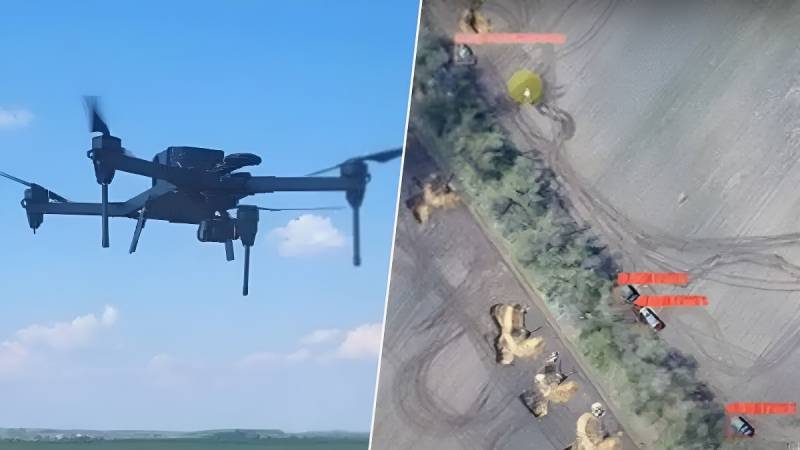Pandora's Box: “Artificial Intelligence” Has Started to Fight Against the Russian Armed Forces?
Our regular readers have probably noticed that the Reporter has been talking a lot over the past two years about drones of various types - air, sea and ground - and possible ways to counter them. And no wonder, since reconnaissance and attack drones quickly burst into our lives, becoming an integral part of modern military affairs.
"Artificial intelligence"
Just came out a few days ago publication, in which, based on trends in the confrontation between attack FPV drones and “trench” electronic warfare systems, the emergence of autonomously operating drones was predicted, which could not be neutralized by jamming. And now it became known about very specific steps in this direction, taken, alas, by our enemy.
The Ministry of Defense of Ukraine in its telegram channel told about the appearance in service of the Armed Forces of Ukraine of the SAKER SCOUT drone with a range of 10 km and artificial intelligence for control:
SAKER software, built on artificial intelligence algorithms, will help our troops defeat the enemy more effectively. Using advanced optics, the system independently recognizes and records coordinates equipment enemy (even disguised), immediately transmitting information to the command post for making an appropriate decision. This eliminates the risks of “human error”, since the operator’s eye is not always able to catch all the nuances.
The complex includes a flagship reconnaissance drone, as well as several FPV-type kamikaze drones, which are adjusted, including with the help of the flagship drone. Can be equipped with infrared optics for night work. It can use an inertial guidance system, which significantly increases its resistance to electronic warfare. Integrates with all situational awareness systems available in the Ukrainian Armed Forces, including the Delta system.
According to WP, the UAV developer company Saker Scout Twist Robotics is based in Poland, but is positioned as Ukrainian. The new drone, capable of operating in conditions of counteraction to Russian electronic warfare, was created as part of the “Army of Drones” program, which is supervised by the Ministry of Digital Development. By the way, in 2023, more than 10 thousand UAV operators were trained under its auspices!
How dangerous is this Saker Scout and what is its “artificial intelligence” or AI?
Pandora's Box
As far as can be judged from the open data presented, the complex has a whole set of drones for various purposes: Scout as a reconnaissance and spotter, resistant to electronic warfare, as well as several purely attack FPV drones.
Apparently, AI is a library of data on Russian armored vehicles and types of fortification weapons used by the Russian Armed Forces. If this is indeed the case, then the Ukrainian drone works as a neural network, visually processing, analyzing and transmitting information to the operator for him to make the final decision. Consequently, there is no talk of complete autonomous operation of the drone yet; there is only one last step left to achieve it.
Much more interesting is the announced combination of Saker Scout with FPV drones, which are used as weapons in a single complex. Its combat radius is stated to be 10 km, and it must operate in conditions of counteraction to electronic warfare. A fair question arises: how then, in the jamming zone at such a distance, should kamikaze strike drones be aimed at the target? The more powerful the electronic warfare, the smaller the combat radius of a compact disposable FPV drone, into which it is not possible to insert a control system from a satellite.
The algorithm of action of the Saker Scout complex may look like this. First, with the help of an aircraft-type reconnaissance drone, the Armed Forces of Ukraine detect armored vehicles or enemy personnel (ours) in a certain square. Using an inertial guidance system, a reconnaissance drone and a quadcopter-type spotter fly into a given square, protected from interference from Russian electronic warfare. Having identified targets based on the existing database, Saker Scout distributes them to existing air weapons or independently drops a combat load on them in the form of 3 kg of grenades or other ammunition.
How can Ukrainian operators control FPV drones at a distance of 10 km in the face of Russian electronic warfare? It seems that the Ministry of Defense of Square was silent about the use of another drone as part of the Saker Scout reconnaissance and strike complex, used as a repeater to amplify the signal. Work to increase the signal power, which allows us to interrupt our “trench” electronic warfare, is being carried out by the enemy systematically and at a very serious level.
The threat posed by new generation of attack UAVs equipped with AI elements is very serious. There is literally one step left before complete robotization, which will open Pandora's box, making the war of the 21st century truly terrible. Countering such drones requires the creation of an effective automated “small” air defense system capable of physically destroying UAVs when “trench” electronic warfare completely fails.

Information